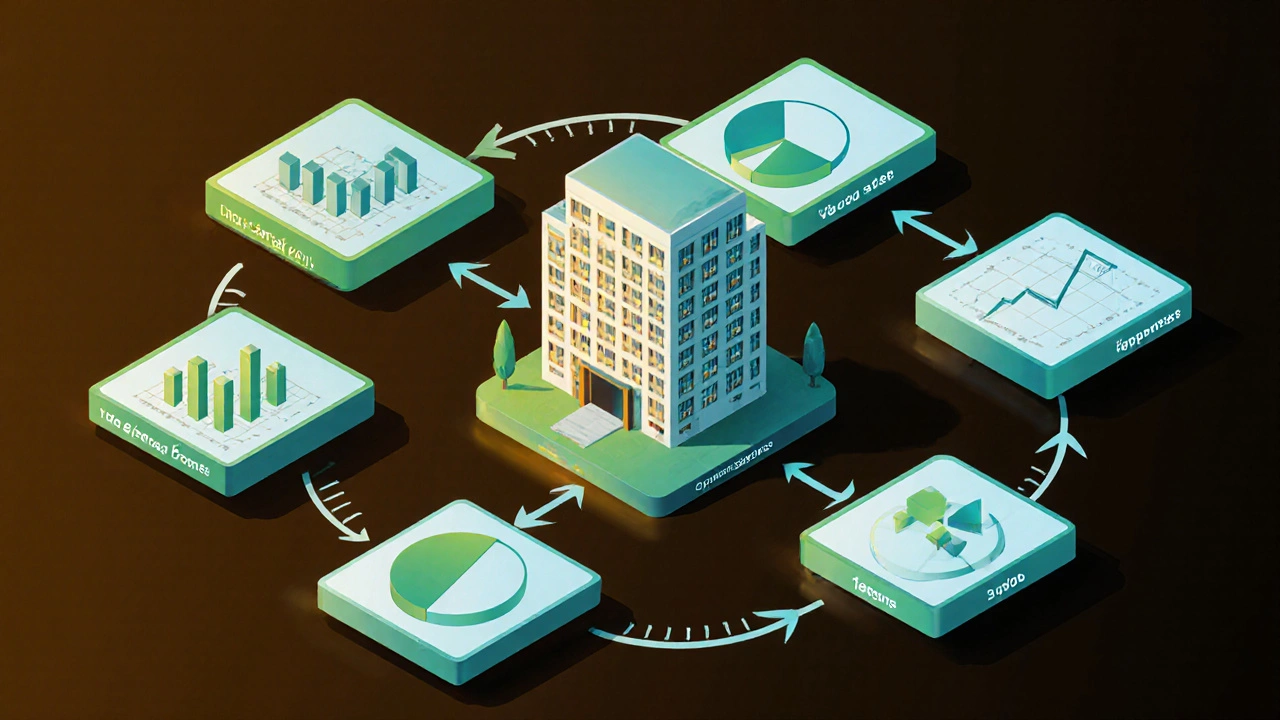Commercial Property Yield Calculator
Calculation Results
Net Operating Income (NOI): £0
Capitalization Rate (Cap Rate/Yield): 0%
Comparison with Benchmark: -
Benchmark Ranges (2025)
| Property Type | London Central | Greater London | Regional Cities | Rural/Suburban |
|---|---|---|---|---|
| Prime Office | 4.0% – 5.0% | 5.0% – 6.0% | 6.5% – 8.0% | 7.5% – 9.0% |
| Secondary Office | 5.5% – 6.5% | 6.5% – 8.0% | 8.0% – 10.0% | 9.5% – 11.5% |
| Retail (High-Streets) | 4.5% – 6.0% | 5.5% – 7.5% | 7.0% – 9.0% | 8.5% – 11.0% |
| Industrial/Warehouse | 5.0% – 6.5% | 6.0% – 8.0% | 7.5% – 9.5% | 9.0% – 12.0% |
Investors constantly ask, “What count as a good yield on a commercial property?” The answer isn’t a single number-it shifts with location, property type, market conditions, and risk appetite. This guide breaks down the math, shows realistic benchmarks for 2025, and gives a practical checklist so you can spot a solid deal before signing any contracts.
Understanding Yield in Commercial Real Estate
At its core, commercial property yield is the annual return an investor earns from a commercial asset, expressed as a percentage of the property’s purchase price or current market value. The most common way to calculate it is the net operating income (NOI) divided by the property’s price.
Here’s how the key pieces fit together:
- Net operating income (NOI) is the property’s gross rental income minus the operating expenses needed to keep it running.
- Gross rental income covers all rent payments a landlord receives before any costs are deducted.
- Operating expenses include property management fees, maintenance, insurance, taxes, and utilities that the landlord pays.
- Vacancy rate is the percentage of space that remains unrented over a year, directly reducing gross rental income.
When you subtract operating expenses and account for vacancies, you arrive at NOI. Divide that figure by the market value, multiply by 100, and you have the cap rate.
Capitalization rate (Cap rate) is another name for commercial property yield, commonly used by investors and appraisers.
Step‑by‑Step: Calculating Yield on a Commercial Property
- Gather the annual gross rental income from leases and any ancillary fees.
- Determine the annual operating expenses. Typical items are a £15,000 management fee, £8,000 insurance, £12,000 maintenance, and £5,000 property tax.
- Estimate the vacancy rate. A healthy office building in central London might see 5% vacancy, while a suburban warehouse could be as low as 2%.
- Calculate NOI:
NOI = (Gross Rental Income × (1-Vacancy Rate)) - Operating Expenses. - Find the current market price or purchase price of the asset.
- Yield = (NOI ÷ Purchase Price) × 100%.
Example: An office building priced at £3million generates £250,000 gross rent, has 5% vacancy, and £80,000 in operating costs. NOI = (£250,000 × 0.95) - £80,000 = £157,500. Yield = (£157,500 ÷ £3,000,000) × 100% ≈ 5.25%.
2025 Yield Benchmarks for UK Commercial Property
| Property Type | London Central | Greater London | Regional Cities (Manchester, Birmingham) | Rural / Suburban |
|---|---|---|---|---|
| Prime Office | 4.0% - 5.0% | 5.0% - 6.0% | 6.5% - 8.0% | 7.5% - 9.0% |
| Secondary Office | 5.5% - 6.5% | 6.5% - 8.0% | 8.0% - 10.0% | 9.5% - 11.5% |
| Retail (high‑street) | 4.5% - 6.0% | 5.5% - 7.5% | 7.0% - 9.0% | 8.5% - 11.0% |
| Industrial / Warehouse | 5.0% - 6.5% | 6.0% - 8.0% | 7.5% - 9.5% | 9.0% - 12.0% |
| Mixed‑Use | 4.5% - 6.0% | 5.5% - 7.0% | 7.0% - 9.0% | 8.0% - 10.5% |
These figures reflect the risk‑adjusted expectations of investors in 2025. Prime assets in central London still command lower yields because of their stability and strong tenant demand. In contrast, suburban or regional assets offer higher yields but come with more exposure to vacancy and market fluctuations.

Key Factors That Push Yield Up or Down
Yield isn’t just a number pulled from a table. Several variables can swing it dramatically:
- Location affects both rent levels and perceived risk. An office near a transport hub commands higher rent but also attracts premium tenants, which can lower the overall yield.
- Tenant quality -creditworthy, long‑term leases reduce vacancy risk and improve yield stability.
- Lease terms such as rent‑free periods, turnover rent, or rent review clauses can alter effective income.
- Property condition impacts operating expenses; a recently refurbished building may have lower maintenance costs, boosting NOI.
- Financing structure: higher leverage can inflate return on equity but also increase risk. Always separate the property’s raw yield (cap rate) from leveraged cash‑on‑cash returns.
What Counts as a “Good” Yield?
There’s no universal rule, but a practical rule of thumb is to compare the property’s yield with the risk‑free rate (UK Gilts) plus a risk premium. In October2025, 10‑year gilts sit around 4.3%. Adding a 2‑3% premium for typical commercial risk gives a baseline of roughly 6%‑7% for attractive opportunities.
If you find an office in Manchester yielding 9%, that’s a strong signal-provided the tenant is solid and the lease is stable. Conversely, a 5% yield on a prime London retail space may be perfectly reasonable because the location and tenant base are exceptionally secure.
Bottom line: a “good” yield aligns with your risk tolerance, investment horizon, and portfolio mix. Use the benchmark table as a starting point, then layer in the specific factors above.
Quick Checklist: Evaluating a Property’s Yield
- Verify the gross rental income figure against lease contracts.
- Calculate realistic vacancy rate based on market data for the sub‑market.
- Audit all operating expenses and identify any one‑off costs that could distort NOI.
- Confirm the tenant’s credit rating and lease expiry dates.
- Compare the computed yield with the benchmark range for the property type and location.
- Assess financing terms: loan‑to‑value ratio, interest rate, and repayment schedule.
- Run a sensitivity analysis: see how a 1% rise in vacancy or a 5% increase in expenses affects the yield.
Common Pitfalls to Avoid
Even seasoned investors slip up. Here are the most frequent mistakes:
- Using gross rent without accounting for vacancy-this inflates the yield.
- Overlooking hidden expenses like security deposits, service charge escalations, or upcoming capital works.
- Relying on outdated market rent surveys; rent growth in 2025 has accelerated in secondary cities.
- Chasing high yields without testing tenant credit; a 12% yield on a vacant warehouse may disappear within months.
- Mixing cap rate with leveraged cash‑on‑cash return-these are distinct metrics and can mislead decision‑making.
Mini FAQ
Frequently Asked Questions
How do I know if a yield is too high?
A yield substantially above market benchmarks often signals hidden risk-such as a weak tenant, high vacancy, or looming capital expenditure. Run a risk‑adjusted analysis before committing.
Can I compare yields across different property types?
Yes, but only after normalising for risk. Retail in prime London typically yields lower than industrial in the Midlands because of stability differences. Use the benchmark table as a reference point.
Should I factor in financing when assessing a property’s yield?
Financing affects your personal return (cash‑on‑cash) but the cap rate remains a property‑level metric. First evaluate the raw yield, then model how debt changes your equity return.
What is a realistic vacancy rate to assume for a new investment?
In 2025, prime London office spaces average 5% vacancy, while secondary city industrial assets sit around 2%‑3%. Adjust the figure based on recent market reports for the specific sub‑market.
How often should I recalculate the yield on an existing property?
At a minimum, review annually after the financial statements close. Major lease renewals, tenant defaults, or capital upgrades also warrant an immediate reassessment.
By grounding your analysis in the proper formula, comparing against current UK benchmarks, and vetting the underlying risk factors, you’ll be able to answer the core question with confidence: you know exactly what qualifies as a good yield for the specific commercial property you’re eyeing.

